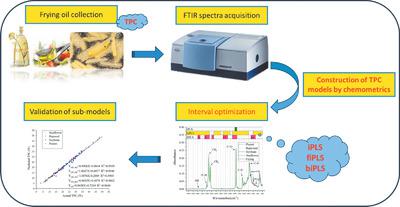当前位置:
X-MOL 学术
›
Eur. J. Lipid Sci. Technol.
›
论文详情
Our official English website, www.x-mol.net, welcomes your
feedback! (Note: you will need to create a separate account there.)
Rapid Determination of Total Polar Compounds in Frying Oil Using ATR‐FTIR Combined with Extended Partial Least Squares Regression
European Journal of Lipid Science and Technology ( IF 1.8 ) Pub Date : 2020-03-12 , DOI: 10.1002/ejlt.201900432 Xiaoying Liu 1 , Qin Ye 1, 2 , Chaogeng Xiao 2 , Ying Zou 3 , Xianghe Meng 1
European Journal of Lipid Science and Technology ( IF 1.8 ) Pub Date : 2020-03-12 , DOI: 10.1002/ejlt.201900432 Xiaoying Liu 1 , Qin Ye 1, 2 , Chaogeng Xiao 2 , Ying Zou 3 , Xianghe Meng 1
Affiliation

|
A method of rapidly determining the total polar compounds (TPCs) in frying oils using attenuated total reflectance‐Fourier transform infrared spectroscopy combined with partial least squares (PLS) regression is developed. Oils of various types and geographic origins are used to ensure that the proposed model is robust. The first derivative spectrum is selected as the spectral processing method. The interval PLS, forward interval PLS, and backward interval PLS algorithms are compared in terms of their performance. A correlation coefficient (R²) of 0.9942, a root mean square error of calibration (RMSEC) of 1.1, a root mean square error of prediction (RMSEP) of 2.30, a residual predictive deviation (RPD) of 4.1, and a limit of detection (LOD) of 1.65% are obtained by the fiPLS33 model with fewer latent variables and a lower spectral interval number. In addition, sub‐models using a single type of oil showed higher performance (R² 0.9957–0.9998, RMSEC 0.12–0.92, RMSEP 0.79–1.58, RPD 4.79–9.64, LOD 0.66–1.26%) than the general model. The TPC models developed are accurate, stable, and adaptable, and they can be used to analyze general frying oil samples quickly, regardless of the oil type, and to analyze samples of specific oil types accurately. Practical applications: The content of TPCs is an important indicator of whether the oil has been overused and whether it will be harmful during the frying process. However, traditional chemical methods are time‐consuming, and they have not been used to determine large‐sized samples. In addition, due to a lack of regional optimization, most studies on determining TPCs with FTIR give unsatisfactory model performance. A general TPC model that incorporates several oil types and regional optimization is expected to improve prediction performance. Therefore, the proposed method represents a rapid and accurate tool for measuring TPCs in edible fats and oils.
中文翻译:

使用 ATR-FTIR 结合扩展偏最小二乘回归快速测定煎炸油中的总极性化合物
开发了一种使用衰减全反射-傅立叶变换红外光谱结合偏最小二乘法 (PLS) 回归快速测定煎炸油中总极性化合物 (TPC) 的方法。使用各种类型和地理来源的油来确保所提出的模型是稳健的。选择一阶导数光谱作为光谱处理方法。对间隔 PLS、前向间隔 PLS 和后向间隔 PLS 算法的性能进行了比较。相关系数 (R²) 为 0.9942,校准均方根误差 (RMSEC) 为 1.1,预测均方根误差 (RMSEP) 为 2.30,残余预测偏差 (RPD) 为 4.1,检测限(LOD) 为 1.65%,由 fiPLS33 模型获得,具有较少的潜在变量和较低的光谱间隔数。此外,使用单一类型机油的子模型表现出比一般模型更高的性能(R² 0.9957–0.9998、RMSEC 0.12–0.92、RMSEP 0.79–1.58、RPD 4.79–9.64、LOD 0.66–1.26%)。开发的TPC模型准确、稳定、适应性强,可快速分析一般煎炸油样品,不分油类,也可准确分析特定油类样品。实际应用:TPCs的含量是判断油品是否被过度使用以及在油炸过程中是否有害的重要指标。然而,传统的化学方法耗时长,且尚未用于测定大尺寸样品。此外,由于缺乏区域优化,大多数使用 FTIR 确定 TPC 的研究给出的模型性能并不令人满意。结合多种油类和区域优化的通用 TPC 模型有望提高预测性能。因此,所提出的方法是测量食用油脂中 TPC 的一种快速而准确的工具。
更新日期:2020-03-12
中文翻译:

使用 ATR-FTIR 结合扩展偏最小二乘回归快速测定煎炸油中的总极性化合物
开发了一种使用衰减全反射-傅立叶变换红外光谱结合偏最小二乘法 (PLS) 回归快速测定煎炸油中总极性化合物 (TPC) 的方法。使用各种类型和地理来源的油来确保所提出的模型是稳健的。选择一阶导数光谱作为光谱处理方法。对间隔 PLS、前向间隔 PLS 和后向间隔 PLS 算法的性能进行了比较。相关系数 (R²) 为 0.9942,校准均方根误差 (RMSEC) 为 1.1,预测均方根误差 (RMSEP) 为 2.30,残余预测偏差 (RPD) 为 4.1,检测限(LOD) 为 1.65%,由 fiPLS33 模型获得,具有较少的潜在变量和较低的光谱间隔数。此外,使用单一类型机油的子模型表现出比一般模型更高的性能(R² 0.9957–0.9998、RMSEC 0.12–0.92、RMSEP 0.79–1.58、RPD 4.79–9.64、LOD 0.66–1.26%)。开发的TPC模型准确、稳定、适应性强,可快速分析一般煎炸油样品,不分油类,也可准确分析特定油类样品。实际应用:TPCs的含量是判断油品是否被过度使用以及在油炸过程中是否有害的重要指标。然而,传统的化学方法耗时长,且尚未用于测定大尺寸样品。此外,由于缺乏区域优化,大多数使用 FTIR 确定 TPC 的研究给出的模型性能并不令人满意。结合多种油类和区域优化的通用 TPC 模型有望提高预测性能。因此,所提出的方法是测量食用油脂中 TPC 的一种快速而准确的工具。











































 京公网安备 11010802027423号
京公网安备 11010802027423号